

Whale Watching on the Great Lakes. Could whale watching on the Great Lakes be the next big thing?
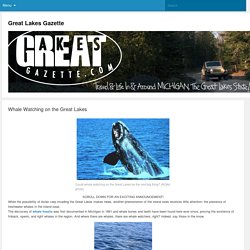
(NOAA photo) While the possibility of Asian carp invading the Great Lakes makes news, another phenomenon of the inland seas receives little attention: the presence of freshwater whales in the inland seas. The discovery of whale fossils was first documented in Michigan in 1861 and whale bones and teeth have been found here ever since, proving the existence of finback, sperm, and right whales in the region. And where there are whales, there are whale watchers, right? Indeed, say those in the know. Great Lakes Whale Watching (provided photo) “The Great Lakes is a fantastic place to observe the annual whale migration,” according to a Great Lakes whale watching charter boat site. The best spotting is done during spring and fall migrations.
In several posts on the FWWANS site folks back up their claims of whale sightings with pictures and whale tales.
POLITICS & GOVERNMENT NEWS. FAKE NEWS. EdWebET110 - Feelings Are Not Facts. ! FINAL Media Lit Prac Guide WEB 112720. Open access, peer-reviewed scholarly and professional journal of the National Association for Media Literacy Education. Namle – National Association for Media Literacy Education. Interactive Media Bias Chart - 2 - Ad Fontes Media. Evaluating Information - Fake News and the Post-Truth Era - LibGuides at Columbia College (SC) Use the C.R.A.A.P.
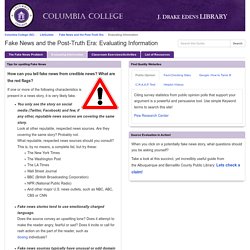
Test to determine whether or not a website is credible. Currency: The timeliness of the information. House Hippo. The house hippo is the subject of a Canadian television public service announcement (PSA) produced by Concerned Children's Advertisers (now known as Companies Committed to Kids) in May 1999 [1] and reintroduced by MediaSmarts in 2019.[2] The original sixty-second clip was directed by Tim Hamilton of Avion Films.
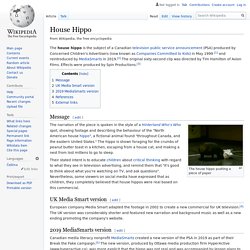
Effects were produced by Spin Productions.[3] Message[edit] The house hippo pushing a piece of paper The narration of the piece is spoken in the style of a Hinterland Who's Who spot, showing footage and describing the behaviour of the "North American house hippo", a fictional animal found "throughout Canada, and the eastern United States.
" On Tech: Take YouTube’s Dangers Seriously. It's Time To Go Mobile While Teaching News Literacy. News and Media Literacy Resource Center. The Chart, Version 3.0: What, Exactly, Are We Reading? - Ad Fontes Media. Note: this is actually version 3.1 of The Chart. I made some minor changes from version 3.0, explained here: Summary: What’s new in this chart: I edited the categories on the vertical axis to more accurately describe the contents of the news sources ranked therein (long discussion below).I stuffed as many sources (from both version 1.0 and 2.0, plus some new ones) on here as I could, in response to all the “what about ______ source” questions I got. Now the logos are pretty tiny. If you have a request for a ranking of a particular source, let me know in the comments.I changed the subheading under “Hyper-Partisan” from “questionable journalistic value” to “expressly promotes views.”
Just read this one more thing: It’s best to think of the position of a source as a weighted average position of the stories within each source. The Moses Illusion Shows How Bad You Are at Fact-Checking. Web Literacy for Student Fact-Checkers – Simple Book Production. 6 Signs of Credible Sources. 6 Signs of Credible Sources: Do Unreliable Websites Sabotage Your Research?

Evaluating web resources is a challenging part of research. In times when anyone can put information on the internet, you can’t tell whether a website is scientific or not from just the first glance. So, how is it possible to distinguish credible sources from hoax websites without spending days doing it? We’ll show you the fastest way to estimate your sources—several tips that can be applied to any kind of website.
What is a Credible Source? How to Evaluate Web Resources - WhoIsHostingThis.com. Practically anyone can create a website. Schools, businesses, government entities, churches, and libraries create websites so people can learn more about what they do. Individuals can create personal sites or blogs to write about their families, friends, work, or any other subject. Corporations can make websites to promote their products, and political activists can publish websites to promote their cause. Anyone with an idea and internet access can create a website and fill it with just about any content they want.
As of 2018, there are over 1.8 billion websites in the world, many of which are protected by free speech and anti-censorship laws. As a result, life online has undoubtedly changed the procedures used to gather and assess information forever. Top 4 Tips To Spot Bad Science Reporting. Ferret Out Fake News Flyer us EBSCO. Assessing Trustworthy Sources Handout EBSCO. School Library Connection Adding Friction. A Preservice Librarian Asks How Can I Teach Triangulation Effectively. Can You Tell Fake News From Real? Study Finds Students Have 'Dismaying' Inability.
Home - Evaluating Information - LibGuides at American Library Association. Evaluating Sources. Story_html5.html&v=10&Cust=92503&DocumentID=42d42695-720a-4493-82e1-27ac405f2386&Popped=True&v=10&InitialPage=story.html&content_token=05f8b1a2-cecd-438e-a4d8-329d15969899&content_endpoint= Story_html5.html&v=10&Cust=92503&DocumentID=42d42695-720a-4493-82e1-27ac405f2386&Popped=True&v=10&InitialPage=story.html&content_token=05f8b1a2-cecd-438e-a4d8-329d15969899&content_endpoint= Making Informed Decisions & Critical Thinking . NOW Classroom . NOW. Making Informed Decisions & Critical Thinking As today's students become ever more involved in using technology as a resource for daily life, it is crucial that we develop students' critical thinking skills to help them decipher the barrage of information available to them and use this information in their opinion-forming and decision-making processes.

Learning Activity: 1. To focus student attention, write all or some of the following quotes on the board/overhead before class begins so students see them when they arrive in the classroom. Lesson07. Fact-Checking. Above The Noise. Top 10 sites to help students check their facts. Document edtechtips turnstudentswebdetectives release. Clone Zone. Remembering the Brooklyn Bridge Elephant Stampede That Never Happened. Brooklyn Bridge Elephant Stampede Home. Staten Island Ferry Disaster Memorial Museum -
20 cognitive biases that screw up your decisions. How to Know If a Source Is Reliable by Shmoop. Critical Thinking Tips - Evaluating Sources - Library Resources Home at Fox Valley Technical College. FotoForensics. Jeffrey Friedl's Image Metadata Viewer. If you have questions about this tool, please see the FAQ.

Find exif data - Online exif/metadata photo viewer. Verification.handbook. Search for images with reverse image search - Google Search Help. You can learn more about an image or the objects around you with a reverse image search.
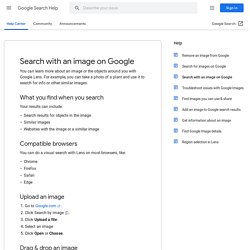
For example, you can take a photo of a plant and use it to search for info or other similar images. What you find when you search Your results can include: Search results for objects in the image Similar images Websites with the image or a similar image. JPEGsnoop (moved to GitHub) download. Digital Literacy. #alternativefacts. Propaganda (noun): Information that is often exaggerated or false and spread for the purpose of benefiting or promoting a specific individual or cause.
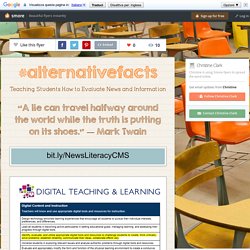
Fake news is, quite simply, news (“material reported in a newspaper or news periodical or on a newscast”) that is fake (“false, counterfeit”) - #alternativefacts Spin Journalism (noun): News and information that is manipulated or slanted to affect its interpretation and influence public opinion. Community of Online Research Assignments. Short Description: This resource and accompanying assignment focuses on evaluating news sources/claims and were used in an online information literacy class.
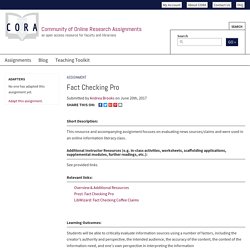
Additional Instructor Resources (e.g. in-class activities, worksheets, scaffolding applications, supplemental modules, further readings, etc.): See provided links. PROVEN source evaluation 9 14 17. Mind Over Media: Analyzing Contemporary Propaganda. MoM Complete Curriculum. Stony Brook Center for News Literacy. The full News Literacy course, developed at Stony Brook University, organizes the material into 8 concepts that are spread amongst our 14 week course that take students from the first information revolution of Johannes Gutenberg's printing press to the Digital Age of Mark Zuckerberg's Facebook.

Each lesson stands alone or can easily be integrated into your program. Below, find a summary of each of those lessons, and a link to the most updated version of the teaching materials for each from our professors at Stony Brook University. Each of the following Course Packs include PowerPoint presentations, associated media, lecture notes, and recitation materials. You will notice as the semester progresses, the name of some of our lessons change, along with the sequence of the lessons. If needed, you can find last semester's course pack at THIS LINK.
Truth, truthiness, triangulation: A news literacy toolkit for a “post-truth” world. We were guaranteed a free press, We were not guaranteed a neutral or a true press. We can celebrate the journalistic freedom to publish without interference from the state. We can also celebrate our freedom to share multiple stories through multiple lenses. But it has always been up to the reader or viewer to make the reliability and credibility decisions. It is up to the reader or viewer to negotiate truth. Mashable. Fake Hurricane Sandy photos flew around Twitter and Facebook on Monday, as users shared jaw-dropping images. Unfortunately, the race to post the most striking pics has most folks skipping the all-important fact check. We've gathered up five "Hurricane Sandy" photographs that have spread on the social web, but weren't actually taken during the massive storm. 11 Viral Photos That AREN'T Hurricane Sandy. Quiz: Are These Hurricane Sandy Photos Real Or Fake?
File:OJ Simpson Newsweek TIME.jpg - Wikipedia. Dog Island Free Forever. RYT Hospital-Dwayne Medical Center. All the miracles of modern medicine.™ How to choose your news - Damon Brown. How the media landscape has changed. Search Better: Evaluate a Webpage Practice - Full Page. Search Better: Judging Online Information - Full Page. Teacher-Librarians. University Libraries, George Mason University. Skip to main content. Domain Age Checker - Domain age tool to check Domain age of a website. The Media Literacy Maven! - NewseumED.
Assignment: Media Literacy. View_interactive. Fact Checker. The definitive Internet reference source for urban legends, folklore, myths, rumors, and misinformation. ProPublica. Media Matters for America. FactCheck.org - A Project of The Annenberg Public Policy Center. Top 10 sites to help students check their facts. Digital Literacy in the Library. Top 10 sites to help students check their facts. How to choose your news - Damon Brown. How the media landscape has changed Media visionary Clay Shirky gave a TED Talk on how the media landscape has changed. “The moment we’re living through, the moment our historical generation is living through, is the largest increase in expressive capability in human history.”
In other words, the amount of information we are capable of capturing is unprecedented. As a result, we need new techniques to filter through the information and need to work much harder than previous generation to better understand our world. Five Laws of MIL. Truth, truthiness, triangulation: A news literacy toolkit for a “post-truth” world. Test Your Awareness : Whodunnit?
Executive Summary 11.21.16. Comet Ping Pong Pizzeria Home to Child Abuse Ring Led by Hillary Clinton. Claim: The 'Podesta e-mails' revealed the existence of a secret society of pedophiles operating through a pizza place loosely connected to Clinton associate David Brock. Evaluating Websites (Lesley Univ.) - English in Action website. Research guide Criteria for the Classroom. Primate Programming(tm) Inc. Microsoft Linux - the premier linux distro. MCG Minnesota Coconut Growers. LASIK@Home. GENOCHOICE - Create Your Own Genetically Healthy Child Online! The Federal Vampire & Zombie Agency. Research Tips: Primary, secondary and tertiary sources.
Using Primary, secondary and Tertiary Sources in Research Let’s say you are writing a research paper on the Equal Rights Amendment (ERA) of 1972, but you are unfamiliar with it. A good place to gather a general idea or understanding of the ERA would be a tertiary source, such as Wikipedia or the Encyclopedia Brittanica. There, you can read a summary of events on its history, key people involved, and legislation. To find more in-depth analysis on the Equal Rights Amendment, you consult a secondary source: the nonfiction book Why We Lost the ERA by Jane Mansbridge and a newspaper article from the 1970s that discuss and review the legislation.
Is Wikipedia a Credible Source in the Academic World? by Nick Alessandrini. Teach your students the right way to Google. Kelly Maher November 24th, 2014. California's Velcro Crop Under Challenge. Republic Of Molossia - Official Website. BuyDehydratedWater.com - The freshest, purest dehydrated water on Earth. Save The Pacific Northwest Tree Octopus. CyberTan - The FREE Internet Tanning Salon. Dorothy&Toto.